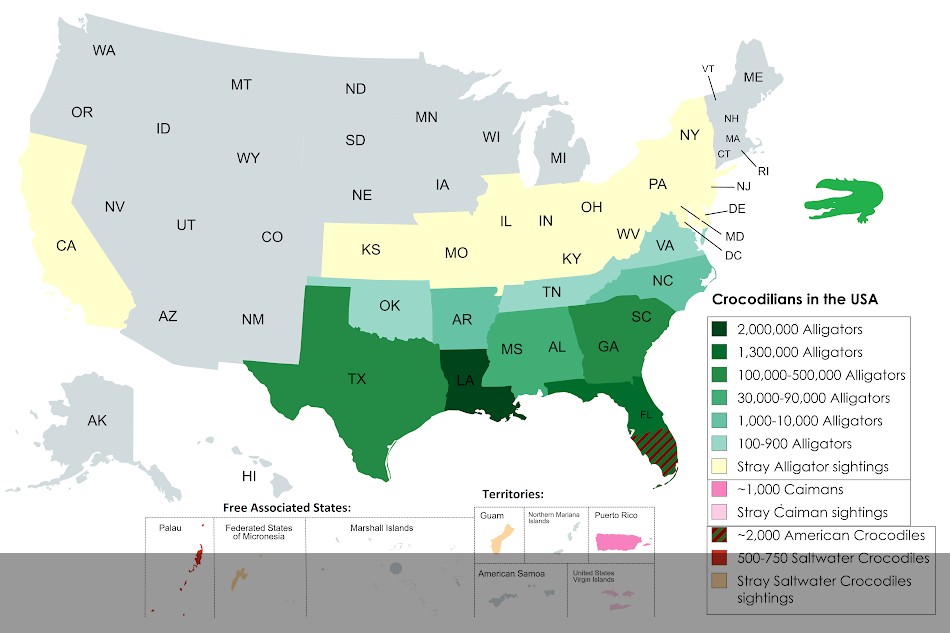Crocodilians in the USA Map


Alex Cartwright
Senior Cartographer & GIS Specialist
Alex Cartwright is a renowned cartographer and geographic information systems specialist with over 15 years of experience in spatial analysis and data...
Geographic Analysis
What This Map Shows
The "Crocodilians in the USA Map" provides a detailed visualization of the distribution of various crocodilian species across the United States. This map highlights the habitats where these reptiles thrive, showcasing both the American alligator and the American crocodile, as well as their respective ranges. By understanding where these creatures live, we gain insight into their ecological roles, conservation status, and interactions with human populations.
Deep Dive into Crocodilians
Crocodilians, which include alligators, crocodiles, caimans, and gharials, are fascinating reptiles that have existed for millions of years. In the United States, the most notable species are the American alligator (Alligator mississippiensis) and the American crocodile (Crocodylus acutus). Both of these species have unique adaptations that allow them to thrive in their respective environments.
The American alligator is typically found in freshwater habitats such as swamps, marshes, rivers, and lakes, primarily in the southeastern U.S. This species plays a crucial role in its ecosystem by helping to control fish populations and creating habitats for other species through its nesting activities. Interestingly, alligators are known to be social creatures, and their vocalizations serve as a form of communication, especially during mating seasons.
On the other hand, the American crocodile prefers coastal habitats, including brackish waters and mangroves, primarily in Florida and parts of the Caribbean. These reptiles are less common than alligators and are classified as vulnerable due to habitat loss and human interference. Adult crocodiles can grow up to 13 feet long, making them one of the largest reptiles in the U.S. Their conservation is critical, as they contribute to the health of coastal ecosystems by regulating prey populations and supporting biodiversity.
An intriguing aspect of crocodilian biology is their ectothermic nature, meaning their body temperature is regulated by external environmental conditions. This adaptation impacts their behavior and habitat preferences, as they often bask in the sun to warm up or seek shade to cool down. Furthermore, both species exhibit parental care, which is relatively rare among reptiles, highlighting their evolutionary success.
Regional Analysis
The map illustrates the distinct habitats preferred by alligators and crocodiles across the U.S. In states like Florida, Louisiana, and Georgia, alligators are abundant, thriving in the swamps and marshes that characterize these regions. For instance, the Florida Everglades serve as a critical habitat for both species, providing the necessary conditions for nesting and hunting. This unique environment supports a rich biodiversity, making it a focus for conservation efforts.
In contrast, the American crocodile's range is much more limited, predominantly found in southern Florida. The Everglades National Park is one of the few places in the U.S. where they can be reliably spotted. The successful coexistence of both species in this area showcases the biodiversity of the region, but it also raises questions about resource competition and habitat preservation.
Interestingly, the populations of these reptiles are not just influenced by geography but also by human activities. Urban development, agricultural expansion, and pollution have led to habitat degradation, posing significant threats to both alligators and crocodiles. Efforts to mitigate these impacts include the establishment of protected areas and conservation programs aimed at preserving their natural habitats.
Significance and Impact
Understanding the distribution of crocodilians in the U.S. is crucial for biodiversity conservation and ecosystem management. These reptiles are indicators of ecosystem health, and their presence often signifies a balanced aquatic environment. However, as climate change and human encroachment continue to alter their habitats, the future of these species hangs in the balance.
Moreover, the interaction between humans and crocodilians presents both challenges and opportunities. In some regions, alligator populations have rebounded, leading to regulated hunts to manage their numbers and reduce human-wildlife conflicts. Conversely, the status of the American crocodile remains precarious, emphasizing the need for ongoing conservation efforts.
As we look to the future, it's essential to monitor crocodilian populations and their habitats closely. With ongoing research and community involvement, we can ensure that these reptiles continue to thrive in the U.S. for generations to come. Have you noticed the increasing conversations around wildlife conservation? The plight of crocodilians serves as a reminder of the delicate balance that exists between nature and human development, urging us all to take action in preserving our natural world.
Visualization Details
- Published
- August 5, 2025
- Views
- 122
Comments
Loading comments...